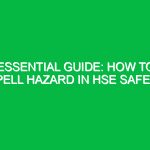Introduction
The **hierarchy of controls** is a systematic approach used within the Health, Safety, and Environment (HSE) domain to mitigate risks and enhance Workplace Safety. Its effectiveness lies in its structured methodology, which prioritizes the most effective methods of risk reduction. Understanding and implementing the hierarchy of controls is crucial for organizations aiming to create safer work environments and ensure the health of their employees.
The concept is simple yet profound: by systematically addressing Hazards in the workplace, organizations can significantly reduce risks associated with various job tasks. This article delves into the components of the hierarchy of controls, its application in the HSE context, and how it can be effectively employed to manage risks efficiently.
The Components of the Hierarchy of Controls
The hierarchy of controls is typically depicted as a pyramid, with the most effective controls at the top. This structure emphasizes a preference for eliminating Hazards rather than merely managing them. The key levels of the hierarchy include:
- Elimination
- Substitution
- Engineering Controls
- Administrative Controls
- Personal Protective Equipment (PPE)
1. Elimination
Elimination involves completely removing the hazard from the workplace. This is the most effective control measure because it addresses the problem at its source. For instance, if a manufacturing process involves a dangerous chemical, eliminating its use and replacing it with a safer alternative can significantly reduce the risk of exposure.
2. Substitution
Substitution entails replacing a hazardous material or process with a less dangerous one. This method is essential when elimination is not feasible. For example, using water-based paints instead of solvent-based ones can reduce harmful emissions and improve air quality.
3. Engineering Controls
Engineering controls are physical modifications to the workplace that help isolate workers from hazards. These include ventilation systems, machine guards, and Safety barriers. For instance, installing a fume hood in a laboratory can effectively minimize exposure to toxic vapors, thereby protecting employees.
4. Administrative Controls
Administrative controls involve changes in workplace policies and Procedures to minimize exposure to hazards. This can include implementing Training programs, establishing work schedules to reduce exposure times, or enforcing safe work practices. For instance, rotating employees in high-risk areas can reduce the likelihood of overexposure to harmful substances.
5. Personal Protective Equipment (PPE)
PPE is the last line of defense and should be used only when other Control Measures are insufficient. This includes items like gloves, helmets, goggles, and respirators. While PPE is essential, relying solely on it can lead to complacency about the underlying hazards. It’s crucial to emphasize that PPE should complement, not replace, higher-level controls.
Benefits of Implementing the Hierarchy of Controls
Adopting the hierarchy of controls framework brings numerous Benefits to organizations, including:
- Enhanced Safety: By systematically addressing hazards, organizations can significantly reduce workplace incidents and injuries.
- Improved Compliance: Adhering to the hierarchy of controls can help organizations meet regulatory requirements, reducing the risk of penalties.
- Increased Productivity: A safer workplace fosters employee morale and productivity, leading to improved overall performance.
- Cost Savings: Reducing workplace accidents can lead to lower insurance premiums, reduced medical costs, and decreased downtime.
Real-Life Applications of the Hierarchy of Controls
To understand the practical implications of the hierarchy of controls, consider the case of a construction site. A company recognized that workers were exposed to falling objects. They implemented the hierarchy of controls in the following manner:
1. **Elimination:** They redesigned the worksite to minimize overhead work where tools and materials could fall.
2. **Substitution:** Instead of using heavy materials, they opted for lighter alternatives that were easier to manage.
3. **Engineering Controls:** They installed nets and barriers to catch falling objects.
4. **Administrative Controls:** They enforced strict protocols for securing tools and materials.
5. **PPE:** Workers were provided with hard hats and Safety Glasses.
This comprehensive approach not only reduced incidents but also fostered a culture of safety among workers.
Potential Hazards and Risks in the Hierarchy of Controls
While the hierarchy of controls is an effective tool, it is essential to recognize potential hazards associated with its implementation. For example, relying too heavily on PPE might lead to neglecting higher-level controls. Additionally, if engineering controls are not properly maintained, they can fail to provide the intended protection.
Organizations must conduct regular assessments to ensure that all levels of the hierarchy are functioning effectively. Regular training and updates on safety policies can help keep employees engaged and aware of the importance of each control measure.
Regulations and Standards
Various Regulations and standards govern the implementation of the hierarchy of controls. For instance, the Occupational Safety and Health Administration (OSHA) in the United States mandates that employers must follow the hierarchy of controls when addressing workplace hazards. Compliance with standards such as ANSI Z10 and ISO 45001 can also enhance an organization’s ability to manage risks effectively.
These regulations not only enforce Safety Measures but also guide organizations in developing comprehensive safety management systems. By understanding and adhering to these standards, organizations can improve their safety performance and reduce the likelihood of incidents.
Best Practices for Implementing the Hierarchy of Controls
To effectively implement the hierarchy of controls, organizations should consider the following Best Practices:
- Conduct Regular Risk Assessments: Identify hazards and evaluate the effectiveness of existing controls.
- Involve Employees: Engage workers in discussions about safety and encourage feedback on potential hazards.
- Provide Training: Ensure that employees understand the hierarchy of controls and the importance of each level.
- Monitor and Review: Continuously monitor the effectiveness of controls and make adjustments as necessary.
- Promote a Safety Culture: Foster an environment where safety is prioritized and valued by all employees.
Conclusion
In conclusion, the hierarchy of controls is a vital framework for effective HSE management. By systematically addressing hazards, organizations can enhance Workplace Safety, improve compliance, and foster a culture of safety. The emphasis on higher-level controls such as elimination and substitution not only protects workers but also contributes to overall organizational success.
As we navigate the complexities of Workplace Safety, it is crucial to remember that no single control measure is sufficient on its own. A comprehensive approach that utilizes the full spectrum of the hierarchy of controls is necessary for effective risk management. Organizations are encouraged to continuously assess their safety practices, engage employees in the process, and strive for ongoing improvement in health, safety, and environmental Sustainability.


